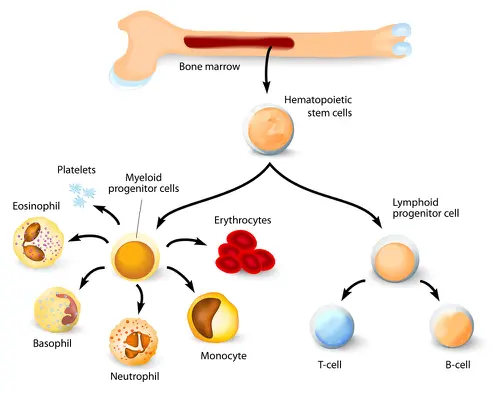Introduction:

Bone marrow is where we make nearly all of our blood, so it is obviously vitally important. It has been estimated that the bone marrow makes more than 220 billion new red blood cells daily. About 1% of the body’s total red blood cells are replaced every day.
It is a busy factory that is always open to make all the cellular blood components. When it is healthy and has all the necessary raw material such as iron, folate and vitamin B12, it can quickly respond to increased demands such as producing more white cells when needed to fight an infections or red cells when we are anemic or platelets when we are bleeding.
If our bone marrow is badly damaged by radiation or chemotherapy, or if most of the normal bone marrow precursor cells are crowded out by cancer, then our prospects can be grim. Bone marrow failure is a dire situation.
That is why our motto has always been to protect your bone marrow and your immunity when choosing a therapy for CLL or any cancer.
Take away Points
- The bone marrow makes nearly all of our cellular blood components.
- It makes up about 4% of our total body weight.
- When it is not functioning, we cannot make red cells, white cells or platelets.
- When healthy, it is responsive and flexible to the changing demands from the rest of the body.
- The marrow is full of primitive stem cells that can make many different types of mature cells.
- The red marrow that makes the blood comprises about half the marrow in adults, but can expand if needed.
- The yellow marrow supports the red marrow and makes various connective tissues.
Structure:
Bone marrow is a soft, jelly-like tissue that fills the centers of bones known as the medullary cavities.
It is protected by the hard outer layer of bone known as the periosteum.
This is the bone that must be pierced in a bone marrow biopsy or aspirate to get to the marrow needed for assessment.

Types of marrow:
There are two types of bone marrow: red and yellow.
Red bone marrow:
Red bone marrow or myeloid tissue consists of a highly vascular, fibrous tissue containing the hematopoietic or blood forming stem cells.
Essentially all red blood cells and platelets in adults are formed in the red bone marrow, which also produces around 60-70% of lymphocytes or white blood cells. The rest of the lymphocytes start out in the red bone marrow, but become fully formed and differentiated in the thymus, spleen, and lymph nodes.
White blood cells last anywhere from a few hours to a few days, platelets for about 10 days, and red blood cells for about 120 days. These cells must be constantly replaced by the bone marrow. For example, the process of a developing and releasing a mature red cell into the blood stream from its bone marrow precursor takes about 7 days.
The red bone marrow also plays a role in the obliteration or destruction of old red blood cells, but the heavy lifting for this task is done in the spleen and the liver.
Yellow bone marrow:
Yellow bone marrow is more fatty and contains mesenchymal stem cells or marrow stromal (connective tissue) cells. These are stem cells that produce mature fat, cartilage, muscle and bone cells.
Yellow bone marrow also stores fats to provide nutrients to the red marrow and to help maintain the correct environment for the bone marrow to function. Under the appropriate conditions, such as severe blood loss or infection, the yellow marrow may convert to red marrow.
In adults, the highest concentration of red marrow is in the bones of the vertebrae, hips or ilium (which is where most bone marrow biopsies are done), the sternum, ribs, skull and at the ends of the humerus (upper arm bone) and the femur (thigh bone) and tibia (shin bone). Essentially all other spongy bones and central cavities of the long bones are filled with yellow marrow.
Both types of bone marrow have a rich blood supply that helps with the ingress of nutrients (supplies for the factory) and the outflow of its labor, the mature blood and stromal cells.

Bone marrow Development
Bone marrow first develops in the collarbone near the end of fetal development and becomes active about 3 weeks later. The liver is the major hematopoietic organ for the fetus in its first 32-36 weeks of gestation and is only superseded by the marrow in the last month or so in utero.
Bone marrow remains all red until around the age of seven. As we age, the red marrow is gradually replaced by yellow fat tissue. Adults have an average of about 2.6 kg (5.7 lbs) of bone marrow, about half of which is red, but again, this amount can increase in response to stress or disease.
Bone marrow stem cells
As we have said, the bone marrow has two types of stem cells, mesenchymal and hematopoietic.
Stem cells are primitive cells that have the capacity to turn into a number of different types of cell. The hematopoietic stem cells in the bone marrow give rise to two main types of cells: myeloid and lymphoid lineages, which include all the different blood cells including monocytes, macrophages, neutrophils, basophils, eosinophils, erythrocytes, dendritic cells, and megakaryocytes or platelets, as well as T cells, B cells, and natural killer cells.
There are different ways to characterize the potential of our hematopoietic stem cells. Some are multipotent, some oligopotent and some unipotent depending on how many types of cell they can create. The multipotent bone marrow stem cell is a hematopoietic cell that can differentiate itself into several types of blood cell types such as lymphocytes or platelets or red cells, but could not become brain or skin cells or other non-blood cell types. An example of the more limited oligopotent stem cell is a lymphoid cell that can differentiate into B and T cells but not into a red blood cell. Finally unipotent cells are those precursor cells that give rise to only one type of cells, such as the megakaryocyte that gives rise to all our platelets.
Mesenchymal stem cells are found in the yellow bone marrow cavity and differentiate into a number of stromal or connective tissues such as chondrocytes cartilage, bone, fat, muscle, endothelial cells and fibroblasts.
Test on the bone marrow:
Bone marrow aspiration uses a hollow needle to remove about 1 ml of liquid bone marrow which can then be examined under a microscope. The needle is usually inserted into the hip or occasionally sternum in adults. A bone marrow biopsy uses a different type of needle that removes a solid core of bone tissue that is fixed and thinly sliced to be examined. The two tests are usually done together.
Dr. Brian Koffman, a well-known doctor, educator and clinical professor turned patient has dedicated himself to teaching and helping the CLL community since his diagnosis in 2005. Dr. Koffman believes that his dual status as a physician and patient provides a unique experience and understanding which allows him to provide clear explanations of complex issues and to advocate for his fellow patients and inform his fellow healthcare providers. This is especially important in view of the rapidly changing therapeutic landscape. Dr. Koffman serves as the unpaid medical director of the CLL Society Inc.
Originally published in The CLL Tribune Q2 2016.


















